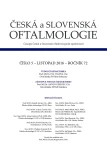Comparing of Treatment Results of Monocanalicular and Bicanalicular Intubation in Inborn Lacrimal Duct Obstruction
Authors:
S. Červenka 1,2,3; Petr Matoušek 2,3; Pavel Komínek 2,3
Authors‘ workplace:
Lacrima oční centrum, s. r. o., Otrokovice
1; Klinika otorinolaryngologie a chirurgie hlavy a krku, Fakultní nemocnice, Ostrava
přednosta prof. MUDr. P. Komínek, Ph. D., MBA
2; Lékařská fakulta, Katedra kraniofaciálních oborů, Ostravská univerzita
vedoucí prof. MUDr. P. Komínek, Ph. D., MBA
3
Published in:
Čes. a slov. Oftal., 72, 2016, No. 5, p. 178-181
Category:
Original Article
Overview
Purpose:
To compare the success rate of monocanalicular (MI) and bicanalicular intubation (BI) in congenital nasolacrimal duct obstruction (CNLDO).
Methods:
MI through the inferior canaliculus and BI were performed under general anaesthesia in children from 7 to 24 months old with CNLDO. Only children after unsuccessful conservative therapy and two and more probings were included in the study. The tubes were removed 3 months after intubation and the therapeutic success was evaluated 6 months after intubation.
Results:
There were performed 139 MI in 114 children and 119 BI in 88 children. The success rate 6 months after intubation is 135/139 (97.1%) in MI, 114/119 (95.8%) in BI and the difference in therapeutic results between MI and BI is not significant (p = 0.737).
Conclusion:
Silicone intubation is an effective procedure for treating CNLDO without difference in therapeutic success between MI and BI.
Key words:
congenital nasolacrimal duct obstruction (CNLDO), monocanalicular intubation (MI), bicanalicular intubation (BI)
Sources
1. Beigi, B., O’Keefe, M.: Results of Crawford tube intubation in children. Acta Ophthalmol, 71; 1993 : 405–407.
2. Crawford, J.S.: Intubation of obstruction in the lacrimal system. Canad J Ophthal, 12; 1977 : 289–292.
3. Červenka, S., Komínek, P.: Silikonová intubace – léčba komplikovaných stavů vrozené neprůchodnosti slzných cest. Čes a Slov Oftal, 53(2); 1997 : 122–127.
4. Dortzbach, R.K., France, T.D., Kushner, B.J., et al.: Silicone intubation for obstruction of the nasolacrimal duct in children. Am J Ophthalmol, 94; 1982 : 585–590.
5. El-Essawy, R.: Effect of timing of silicone tube removal on the result of duct intubation in children with congenital nasolacrimal duct obstruction. Opthal Plast Reconstr Surg, 29(1);2013 : 48-50.
6. Engel, J.M., Hichie-Schmid, C., Khammar, A., et al.: Monocanalicular silastic intubation for the initial correction of congenital nasolacrimal duct obstruction. J AAPOS, 11; 2007 : 183–186.
7. Fayet, B., Bernard, J.A.: A monocanalicular stent with self-stabilizing meatic fixation in Sumery of excretory lacrimal ducts. Initial results. Ophthalmologie, 4; 1990 : 351–357.
8. Fayet, B., Bernard, J.A., Assouline, M., et al.: Bicanalicular versus monocanalicular silicone intubation for nasolacrimal duct impotency in childhood. Orbit, 12; 1993 : 149–156.
9. Goldstein, S.M., Goldstein, J.B., Katowitz, J.A.: Comparison of monocanalicular stenting and balloon dacryoplasty in secondary treatment of congenital nasolacrimal duct obstruction after failed primary probing. Opthal Plast Reconstr Surg, 20; 2004 : 352–357.
10. Kaufman, L.M., Guay-Bhatia, L.A.: Monocanalicular intubation with Monoka tubes for the treatment of congenital nasolacrimal duct obstruction. Opthalmology, 105; 1998 : 336–341.
11. Komínek, P., Červenka, S., Novák, V.: Intubace odvodných slzných cest – přehled některých technik. Čes a Slov Oftal, 53(1); 1997 : 32–39.
12. Komínek, P., Červenka, S., Novák, V.: Intubation of the lacrimal pathways. Ophthalmologica, 214; 2000 : 381–384.
13. Komínek, P., Červenka, S., Pniak, T., et al.: Monocanalicular versus bicanalicular intubation in the treatment of congenital nasolacrimal duct obstruction. Graefes Arch Clin Exp Opthalmol, 249; 2011 : 1729–1733.
14. Lee, H., Ahn, J., Lee, J.M., et al.: Clinical effectiveness of monocanalicular and bicanalicular silicone intubation for congenital nasolacrimal duct obstruction. J Craniofac Surg, 23(4); 2012 : 1010–1014.
15. Lim, C.S., Martin, F., Beckenham, T., Cumming, R.G.: Nasolacrimal duct obstruction in children: outcome of intubation. J AAPOS, 8; 2004 : 466–472.
16. Meyer, D.R., Antonello, A., Linberg, J.V.: Assessment of tear drainage after canalicular obstruction using fluorescein dye disappearance. Ophthalmology, 97; 1990 : 1670–1674.
17. Migliori, M.E., Putterman, A.M.: Silicone intubation for the treatment of congenital lacrimal duct obstruction: successful results removing the tubes after six weeks. Ophthalmology, 95; 1988 : 792–795.
18. Noda ,S., Hayasaka, S., Setogawa, T.: Congenital nasolacrimal duct obstruction in Japanese infants: its incidence and treatment with massage. J Pediatr Ophthalmol Strab, 28; 1991 : 20–22.
19. Nucci, P., Capoferri, C., Alfarano, R., et al.: Conservative management of congenital nasolacrimal duct obstruction. J Pediatr Ophthalmol Strab, 26; 1989 : 39–43.
20. Pediatric Eye Disease Investigator Group.: Primary treatment of nasolacrimal duct obstruction with nasolacrimal duct intubation in children younger than 4 years of age. J AAPOS, 12; 2008 : 451–455.
21. Pelit, A., Caylakli, F., Yaycioglu, R.A., et al.: Silicone intubation with the Ritleng method unsing intranasal endoscopy to treat congenital nasolacrimal duct obstruction. Int J Pediatr Otorinolafyngol, 73; 2009 : 1536–1538.
22. Quickert, M.H., Dryden, R.M.: Probes for intubation in lacrimal drainage. Tr Am Acad Ophth Otol, 74; 1970 : 431–433.
23. Ratliff, C.D., Meyer, D.R.: Silicone intubation without intranasal fixation for treatment of congenital nasolacrimal duct obstruction. Am J Ophthalmol, 118; 1994 : 781–785.
24. Takahashi, Y., Kakizaki, H., Chang, W.O., et al.: Management of congenital duct obstruction. Acta Opthalmol, 88; 2010 : 506–513.
25. Welsh, M.G., Katowitz, J.A.: Timing of silastic tubing removal after intubation for congenital nasolacrimal duct obstruction. Ophthal Plast Reconstr Surg, 5(1); 1989 : 43–48.
Labels
OphthalmologyArticle was published in
Czech and Slovak Ophthalmology

2016 Issue 5
Most read in this issue
- Blepharophimosis-ptosis-epicanthus inversus syndrome
- Iris melanoma in a child
- Preimplantation genetic diagnosis and monogenic inherited eye diseases
- The Tear Osmolarity of PATIENTS with Lagophthalmos
